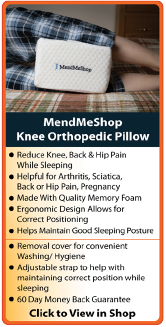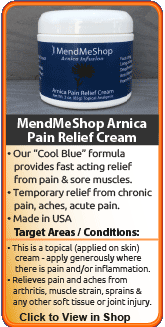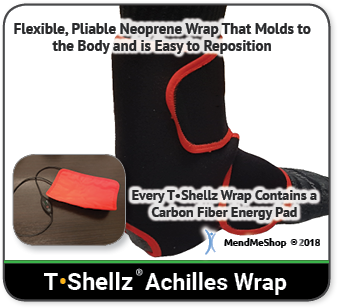Achilles Stretching and Exercise:
The Final Step in Achilles Tendon Recovery
Stretching & Exercise + Achilles TShellz Wrap® =
An Optimal way to Deal with Scar Tissue at Home

Stretching is an important part of conservative treatment for the Achilles tendon. Stretching is even recommended for people with healthy Achilles tendons because regular stretching will maintain flexibility of the tissue as it ages. When the Achilles tendon is injured, stretching plays a huge role in conservative treatment protocols. This can be in both the case of achilles injuries that do not require surgery and also in cases of post-surgery recovery (typically assigned and prescribed by your physical therapist (PT) and/or surgeon).
For many people, stretching seems like a basic thing but you would be surprised by how many people there are that don't understand the importance of stretching an Achilles tendon. Before making the transition to crutches, PTs typically prescribe gentle stretching of an injured Achilles. They don't prescribe this to annoy you - it is in fact the most important part of Achilles tendon recovery. You may know of someone that chose not to do these stretches (a common problem) - and they may have paid a high price for it. By not listening to the therapist (i.e. not stretching), you are at greater risk of re-injuring your Achilles or even sustaining an injury greater than the original injury ever was.
During the healing process your body will fill in tears in your tendon with dense, brittle tissue called "scar tissue". The human body will use scar tissue as a temporary solution for reattaching both microscopic and major tissue tears. The body will try to build scar tissue as fast as possible to heal a tissue tear in the Achilles tendon. Scar tissue can form fast to bring together the edges of a tear, but when scar tissue forms it doesn't come together as neatly as regular (healthy) Achilles tendon tissue would. Scar tissue fibers will lay down over top of your tear in a cluttered, messy and jumbled up way, and attach to everything it can reach.
This is why scar tissue is a temporary solution to heal your Achilles tendon and is something that in nearly all cases should be dealt with quickly. If you try to get back into your regular daily activities with a mound of scar tissue on your Achilles tendon you will have a higher risk of re-injury. Scar tissue is just not built to withstand the pressures of regular activity.
If you have an Achilles tendon injury with a lot of scar tissue and re-injure that tissue, even more scar tissue will grow to fill in those tears - this is the crux of the problem, a scar tissue based reinjury cycle. If you keep falling into a dangerous cycle of re-injuring your Achilles tendon without proper treatment you will probably have a continuous buildup of scar tissue - you may even see the lump it might make on the back of your heel. Your ability to move your ankle and Achilles tendon in a normal way will be further impaired as the amount of scar tissue increases on your Achilles tendon.
Even when you're injured and in pain you need to keep moving to break-up scar tissue that's forming in your tendons and ligaments. Moving when you are injured is hard, yet regular movement can increase healthy range of motion (ROM) of your heel and ankle, guaranteeing you a speedier recovery process and return to regular activities. Since moving while injured can be painful most people think it's better to stop moving, rest their achilles and hope that their achilles injury will heal all on its' own. Even though rest is important to recovery, too much rest during the recovery process will increase the amount of scar tissue in your ankle. This is why you really need to listen closely to your PT - they know what stretches you need to do and how often you should do it!
It may seem hard to believe but it's true... Stretching is the secret of healing an Achilles tendon injury. Consistent stretching is one of the few solutions to break up scar tissue that forms on your Achilles tendon as it heals.
Stretching, combined with Circulatory Boost
(via the TShellz Wrap®) is even better!
Achilles Atrophy is arguably a bigger issue than scar tissue. Whether you have an ankle injury or have recently had an operation, you will find that the joint has a more limited range of motion than you had before. In most cases, this is due to atrophy - the shortening of connective tissue in the ankle due to inactivity. In cases where atrophy exists, it is very important to stretch and do gentle exercise to nip this problem in the bud before it becomes a chronic (long-lasting) issue. If you are currently recovering from a knee injury speak with your physician about stretches and exercise.
Some people will listen to the advice of their PT when stretching out their Achilles tendon for more complete healing. It is very common for a PT to combine conservative treatments and stretching techniques to help you heal your Achilles tendon. They will also probably give you advice to continue specific stretches at home, everyday, to increase your rate of recovery. If no device is available to allow for consistent stretching of the Achilles tendon at home the PT will usually prescribe something called "heel slides".
A "heel slide" is basically a full flex and extension of your lower leg. Heel slides can be performed in a seated or laying down position. To start this movement you first need to slide your heel in toward your body, then you slide it right back out away from your body.
Heel slides (full heel to hip movement) is nothing new... Common stretching practices like Pilates, Yoga and other fitness techniques all encourage heel to hip movement to firm, tone and condition the body. This movement is also used to increase alignment of your leg from your heel to your hip and improve your lower body balance. A lot of muscle, tendon and ligament groups are involved in this stretch - like your Achilles tendon, the ligaments in your ankle, your calf muscles, your entire knee, your hip, your hamstring and your quadriceps muscles. This is why heel slides are considered to be a foundation stretch in Achilles tendon rehabilitation.
When PTs perform heel to hip stretching they will usually advise you to take a seat on the ground or on their massage/manual manipulation table in the clinic.
They will also instruct you to remain seated or lay down, and move your heel out away from your body so your leg is straight, then slowly move your leg in toward your lower back, bending your knee. In a PT clinic they can even perform manual manipulation - where they move your leg for you so they can feel your Achilles tendon and the calf muscles in your leg to see how your body reacts to the stretch.
You will slowly get the hang of this movement in PT and your therapist will recommend that you continue a set of heel slide stretches several times each day in your own home.
When attempting this stretch on your own outside of your PT's office, your PT will encourage you to use a plastic bag, cookie sheet, tension band, belt or other tool to help you slide your heel away from your body. They recommend these tools to help you get consistent stretching and assistance during your stretching routine.
Eventually you will reach a stage where your injured leg/ankle can handle crutches or standing for longer and longer periods of time. This is the final stage of recovery, depending on your age, the nature of your injury, your weight and many other factors, it can take the longest time to complete.
But remember, when it comes to Achilles tendon injuries - it pays to be patient! Rushing your injury recovery almost never pays.
There is a Unique Formula for the Achilles Tendon...
If you haven't noticed this yet, you will now see that we are sharing this key piece of information with you. During your PT appointment your PT will probably use or assign conservative treatments, massage, manual manipulation and/or stretching exercises. In most cases, it follows a 3 step formula:
Step 1 - Warm Up Your Achilles Tendon
For this first step, many PTs will use heat, manual manipulation, deep tissue massage, clinical ultrasound devices or a hot bath to warm up your Achilles tendon. The goal during this first step is to increase healthy blood flow circulation and relax your Achilles tendon tissue. Warming up your Achilles tendon will increase the elastic-nature of your tendon making it much easier to stretch. This will also extend the amount that you will be able to stretch your Achilles tendon.
If you want to warm up your achilles at home before stretching, use an Achilles TShellz Wrap for 10 to 20 minutes at least half an hour before starting your stretches. An Achilles TShellz Wrap will promote blood flow to your Achilles tendon while warming up and relaxing tendons, muscles and ligaments in the treatment area. Circulatory Boost will temporarily make your Achilles tendon tissue more elastic and pliable, allowing for more ease of movement when you are stretching and/or exercising.
Step 2 - Exercise/Stretch Your Achilles Tendon
The main goal of PT is to exercise (stretch out) the affected area to improve flexibility and range of motion. After the PT has warmed up your Achilles tendon, they will get you to do a series of exercies that are focused on stretching out your Achilles tendon. This exercise may include focused stretches for the Achilles tendon, ankle and/or calf muscles and even some cardiovascular exercise on a stationary bicycle or treadmill.
Your legs support an intense amount of weight every day! In order to handle the pressures put on them, you must keep your muscles and tendons strong. Use stretching exercises (assigned by your PT) to increase strength and flexibility of your leg with smooth controlled movements. You can start out small and increase at your own, slow but safe pace. Minimize your chance of re-injury and decrease your time spent in pain and discomfort.
Your full recovery depends on your commitment to stretching and strengthening exercises. Your PT will develop an effective program during your clinic visits for your recovery. But ask any therapist, the key to a successful recovery is commitment to at home exercise!
Step 3 - Cool Down Your Achilles Tendon After Stretches/Use
Toward the end of your appointment your PT may introduce cold compression, acupuncture, or TENS to relax your Achilles tendon tissue after exercise.
These conservative treatment methods are also used to reduce on-going pain from your Achilles tendon injury and prevent further re-injury to your tendon.
Use of a Cold Compress or Ice Pack after stretching/exercising your Achilles tendon will help relieve any on-going pain and swelling while preventing full-blown inflammation from returning after your stretching. Start with a short treatment directly after activity and apply more cold as needed to relieve pain and inflammation in the ankle and Achilles tendon.
As we mentioned before, after you've injured your Achilles tendon scar tissue will grow all around your Achilles tendon tear to provide a "temporary fix" and increase stability of your Achilles. Scar tissue will constantly grow when you are suffering from a chronic Achilles tendon injury like tendonitis, tendinosis, or tensynovitis, and even when you are recovering from Achilles tendon surgery.
Scar tissue is probably the cause of your Achilles tendon, ankle ligaments or even your calf muscles stiffening up over time.
The Next Step Is Up To You!
AidMyAchilles is committed to bringing you the absolute best quality products we can for helping you relieve pain and heal your Achilles tendon injury as quickly as possible.
So, if you're looking to supplement your PT by stretching at home, you may find the Achilles TShellz Wrap® to be a powerful tool for helping you recover from an Achilles tendon injury quickly while reducing your risk or reinjury. If you're looking to increase your flexibility and strengthen your Achilles tendon and lower leg muscles as fast as you possibly can; the Achilles TShellz Wrap combined with a stretching program is really the best way to go.

The bottom line is, you are welcome to try our products for a full 2 months. If you do not receive the benefits that others have experienced, simply call us to return your purchase back to us and we will issue a prompt & full refund. There will be no hassle and no hard feelings.
If you are still uncertain which route to go or if you would like to discuss issues affecting your Achilles tendon, ankle, calf muscle, lower leg or other soft tissue injuries, then do not hesitate to contact an AidMyAchilles Adviser immediately by phone or email.
North America Toll Free 1-866-237-9608
Outside North America +1-705-532-1671
Monday to Friday 9:00 am to 5:00 pm (Eastern Standard Time)
AidMyAchilles Advisers do not work on commission, so be assured you will only receive fair and objective information.
Learn More About Achilles Injuries & TreatmentsI want to learn more about Achilles Surgery & Post-Surgery Recovery I want to learn more about Circulation Boost I want to learn more about Ice & Heat: Which Is Better For The Achilles? I want to learn more about Stretching for the Achilles
FREE SHIPPING ON ALL PRODUCTS CURRENTLY ENABLED
60 DAY TRIAL PERIOD
During your recovery, you will probably have to modify and/or eliminate any activities that cause pain or discomfort at the location of your soft tissue injury until the pain and inflammation settle. The more diligent you are with your treatment and rehabilitation, the faster you will see successful results!
| 















